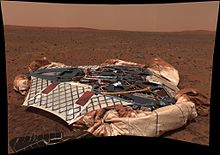Lander (spacecraft)

A lander is a spacecraft which descends toward and comes to rest on the surface of an astronomical body. For bodies with atmospheres, the landing is called re-entry and the lander descends as a re-entry vehicle. In these cases landers may employ aerobraking and parachutes to slow down, often with small landing rockets which fire just before impact to bring the lander to rest relatively gently. The Mars Pathfinder mission also used inflatable airbags to cushion the lander's impact. When a high velocity impact is planned, the spacecraft is called an impactor.[1]
Comet and asteroid landers
The Rosetta probe, launched 2 March 2004, is planned to put a lander on comet 67P/Churyumov-Gerasimenko in 2014; due to the extremely low gravity of such bodies, Rosetta's landing system includes a harpoon launcher intended to anchor a cable in the surface and pull it down. This strategy of attaching to an asteroid was originally proposed by Eugene F. Lally of the Jet Propulsion Laboratory in a paper describing missions to asteroids and asteroid landing techniques.
A landing on a similarly small body, the asteroid 433 Eros, was performed by the probe NEAR Shoemaker despite the fact that NEAR was not originally designed to be capable of landing.
The Hayabusa probe made several attempts to land on 25143 Itokawa with mixed success, including a failed attempt to deploy a rover.
Jupiter entry probe
The Galileo probe dropped a small reentry vehicle into the atmosphere of Jupiter, but as Jupiter is a gas giant with no well-defined surface it is debatable whether this was a "lander" per se.
Moon landers
Historic
A number of Moon probes, such as some members of the Soviet Luna program and the American Ranger program, were hard-impact landers which were not intended to continue providing useful data after their high-speed landings.
The Soviet Luna 9 was the first spacecraft to achieve a lunar soft landing and to transmit photographic data to Earth. The American Surveyor program was designed to determine where Apollo could land safely; thus these robotic missions required soft landers to sample the lunar soil and determine the thickness of the dust layer, which was unknown before Surveyor.
The Apollo Lunar Modules and Lunakhod landers used a rocket descent engine for a soft landing of astronauts and lunar rovers on the Moon.
Planned
The Altair spacecraft, previously known as the "Lunar Surface Access Module" or "LSAM", is the planned lander for Project Constellation. As part of Project Constellation, NASA intends to conduct Moon landings beginning around 2020.
Titan lander
The Huygens probe, carried to Saturn's moon Titan by the Cassini probe, was specifically designed to survive landing on land and on liquid. It was thoroughly drop-tested to make sure it could withstand impact and continue functioning for at least three minutes. However, due to the low speed impact, it continued providing data for more than two hours after it landed.
Terrestrial planet landers
The terrestrial planets have been frequent targets of lander-based exploration missions. No lander mission to Mercury has been attempted, but both Venus and Mars have been the target of exploration missions.
Venus
The Soviet Venera program included a number of Venus landers, some of which were crushed during descent much as Galileo's Jupiter "lander" and others of which successfully touched down. The Soviet Vega program also placed two balloons in the Venusian atmosphere.
Mars
The Soviet Union's Mars 2 lander was the first manmade object to reach the surface of Mars in 1973, but communication was lost within a minute after touchdown, which occurred during one of the worst global dust storms since the beginning of telescopic observations of the Red Planet. Three other probes, Mars 3, Mars 5, and Mars 6, either crashed or failed to even enter the planet's atmosphere during the 1973 and 1975/76 windows. All four landers were based on the Luna 9 lander, required the use of an aeroshell-like heat shield during atmospheric entry.
Vikings 1 and 2 were launched respectively in August and September 1975, each comprising an orbiter vehicle and a lander. Viking 1 landed in July 1976 and Viking 2 in September 1976. The Viking program ended in May 1983, after both landers had died.
Mars Pathfinder was launched in December 1996 and released the first rover on Mars, named Sojourner, in July 1997. It failed in September 1997, probably due to electronics failure caused by the cold temperatures.
Mars Polar Lander lost communication on December 3rd, 1999.
The European Beagle 2 lander deployed successfully from the Mars Express spacecraft but the signal confirming a landing which should have come on 2003-12-25 was not received. Indeed no communication was ever established and Beagle 2 was declared lost on 2004-02-06.

Mars Exploration Rovers Spirit and Opportunity were launched in June and July (respectively) 2003. They reached the Martian surface in January 2004 using landers featuring airbags and parachutes to soften impact. As of June 2008[update], both rovers are still active, having survived more than four years when their design lifetime was three months.
The U.S. Phoenix spacecraft successfully achieved soft landing on the surface of Mars on May 25, 2008, using a combination of parachutes and rocket descent engines.
References
- ^ "Technology: Impactor". NASA.
